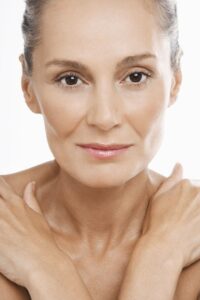November 26, 2015 | 3 minute read
 Are you tired of looking so tired? Do dark splotches on your face make you look more like your mother than your youthful, fun-loving self? Laser skin resurfacing revitalizes the skin and reverses the effects of age, sun, and lifestyle habits like smoking. Short bursts of concentrated light are directed at affected areas of the skin, precisely removing the top layer and exposing softer, clearer skin underneath. The treatment is used to reduce the appearance of wrinkles, acne scars, and age spots, while smoothing and tightening the skin. To find out if you are a good laser skin resurfacing candidate, contact our San Francisco practice today.
Are you tired of looking so tired? Do dark splotches on your face make you look more like your mother than your youthful, fun-loving self? Laser skin resurfacing revitalizes the skin and reverses the effects of age, sun, and lifestyle habits like smoking. Short bursts of concentrated light are directed at affected areas of the skin, precisely removing the top layer and exposing softer, clearer skin underneath. The treatment is used to reduce the appearance of wrinkles, acne scars, and age spots, while smoothing and tightening the skin. To find out if you are a good laser skin resurfacing candidate, contact our San Francisco practice today.
Who Makes a Good Candidate for Laser Skin Resurfacing?
Candidates for laser skin resurfacing should be in general good health, with a positive attitude and real expectations of what to expect from the procedure. Candidates may have sun-damaged skin with fine wrinkles and a leathery texture. They may have wrinkles around the eyes and vertical wrinkles around the mouth. They might have scars from acne or chicken pox, or have blotchy skin with brown spots.
The technique is not recommended for stretch marks, and if you currently have acne or very dark skin, you may not qualify. The best way to find out if you are a good candidate for the procedure is to come in for a consultation with Dr. Henry.
The Lasers
There are two different types of lasers for skin resurfacing. The CO2 laser has been used for years to treat skin conditions such as wrinkles, warts, and scars. Short pulses of light remove skin one, thin layer at a time. The CO2 laser causes minimal heat damage, and recovery typically takes up to two weeks. The Erbium laser targets deeper lines and wrinkles. This laser causes less heat damage and has fewer side effects, so recovery may be as short as one week.
The Laser Skin Resurfacing Procedure
Laser resurfacing is an outpatient procedure. Depending on the area being treated, the doctor may use a local anesthetic or a more potent form of anesthesia. The procedure will take 30 to 45 minutes for small areas, but treating the whole face may take up to two hours.
When the procedure is complete, the doctor will apply a bandage. Beginning 24 hours after treatment, you will need to clean the area several times a day. Apply the provided or prescribed ointment to prevent scabs from forming. The doctor may prescribe steroids to manage swelling after the procedure. Apply a cold pack on the treated area for the first day or two to reduce swelling, and use an extra pillow to keep your head elevated at night.
About a week after the procedure, the treated skin will peel. Once it has healed, oil-free makeup may be worn to cover the redness. You will need to limit your time in the sun, wearing a sunscreen of at least 30 SPF if you will be outside. Be sure to always keep your refreshed skin well moisturized.
Contact Us for a Consultation
If you wish to treat sun damage and wrinkles, contact our office to schedule a consultation. A reputable cosmetic surgeon, Dr. Kimberly Henry will help you decide if laser skin resurfacing or an alternative treatment will be best suited to meet your needs and expectations.

